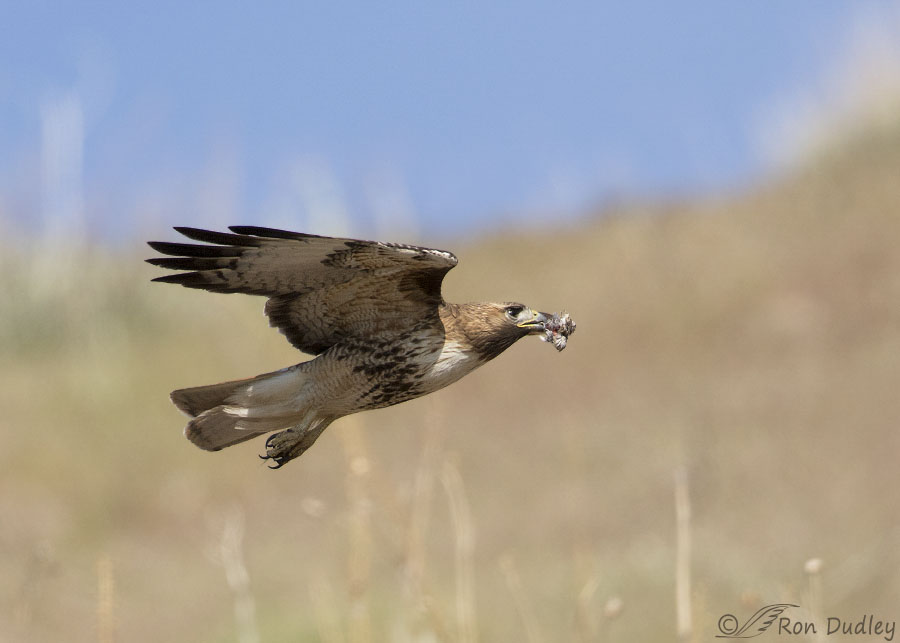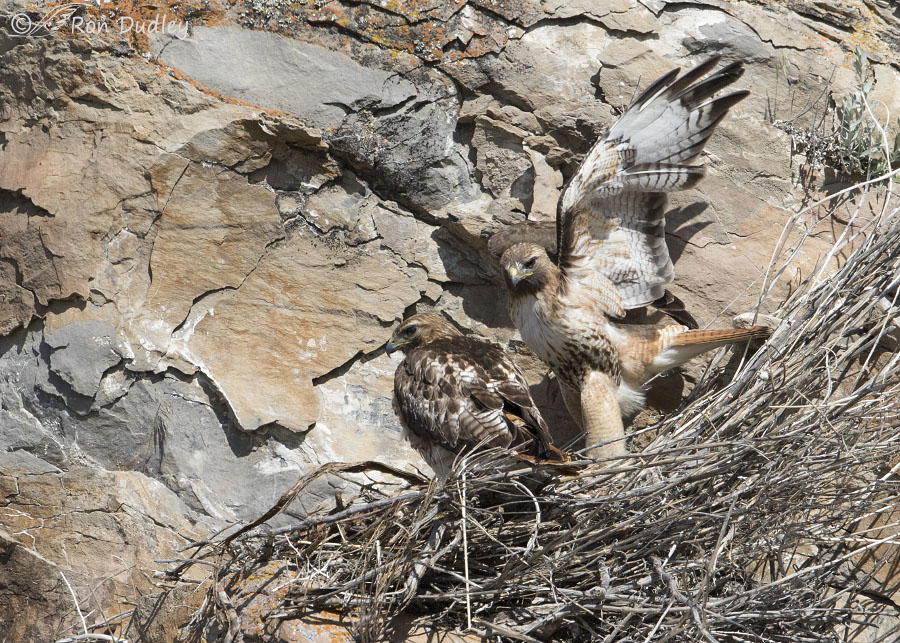This male was a good provider for his mate and soon-to-be offspring.

1/3200, f/6.3, ISO 640, Canon 7D Mark II, Canon EF 500mm f/4L IS II USM + EF 1.4 III Extender, not baited, set up or called in
I photographed him exactly 1 year ago today as he approached his mate on their nest on a cliff to the right. I’m not sure what the food item in his beak was but I’m confident it wasn’t a vole which was their most common prey. My bet would be that it’s a portion of rabbit.
The horizon appears tilted because it actually was tilted – it’s a slope leading up to the cliff.

1/2500, f/7.1, ISO 500, Canon 7D Mark II, Canon EF 500mm f/4L IS II USM + EF 1.4 III Extender, not baited, set up or called in
When he presented the food to his mate at the nest she accepted it but wouldn’t/didn’t eat it until he left, which is what he’s in the process of doing here soon after the delivery..
These hawks aren’t using the nest this year – instead they’ve constructed a new one. It would be interesting to know their reasons for making that decision. The old nest survived sometimes brutal winter winds mostly intact in a relatively protected spot so their abandonment of the old nest surprised me a little.
Ron
Note: I won’t bore you with all the details (again) but suffice it to say I was very careful to avoid disturbing these birds in the area of their nest or anywhere else.


Figures that you’d post a redtail family on a day when I ignored the computer because it’s just too annoying.

ANYWAY, I MIGHT could shed a little light on your questions. It’s not unusual for redtails (and many other raptors) to rotate nests. My GUESS is they leave the nest to sit in the sun (and other weather conditions) to allow natural forces to clean and disinfect (if you will) all the nasties that happen as a result of raising kids. Another possible explanation is that Ms. Redtail suggested another site that would be better/safer for whatever criteria she uses for site selection.
As for their nest construction, that comes under the heading of who needs thumbs? A friend of mine who breeds goshawks often remarks that the female weaves those sticks together so that only a few catastrophic events are likely to undo her efforts. He delivers sticks, does his best to weave them as she eats and flies around the chamber and she responds with something like “give me that! You’re doing it wrong!” (That’s pretty much the same response Arthur and Ezra before him received from Big Red in the Cornell nest). Anyway, when my human friend comes in later or the next day, he’s literally unable to dislodge that same stick. And he’s a healthy and strong human male!! So, the question of who needs thumbs is valid
Wonderful shots Ron! Curious why they decided to move.
Charlotte
Me too, Charlotte. They didn’t move far but they moved…
Fabulous shots! Those pantaloons in the 2nd shot are something else! And I, for one, never find your details boring!
“And I, for one, never find your details boring!”
Just give me enough opportunities and it’ll happen, Marty!
I’ll never get bored by your posts!
Me either!!
Again, one of your beautiful red-tailed hawk images reminded me that they are sometimes called “little brother to the eagle”…I think it’s the shape and size of the bird as much as the coloration…any way, this first image is beautiful and the second an interesting capture…like them both…..
Thank you, Patty. I’m glad you like them both.
Beautiful photos. Given where the male got the food item and the location of the nest, the horizon of the first photo makes perfect sense. Another reason it makes sense is that the blurry stems in the foreground are vertical… I always enjoy seeing Red-tail Hawks.
Susan, I actually used those blurry stems to rotate that photo to level.
Great action photos Ron. Lots of raptor activity with fledglings and juveniles this time of the year.
Everett Sanborn, Prescott AZ
Thanks, Everett.
We need Laura.
My immediate thought was mites – but my thoughts are not based on anything more than a barely educated guess. I hope their new nest is a big success.
Wow, my jaw dropped to get a comment from you this time of the morning, EC (late at night for you…). Don’t forget to go to get some sleep !
I am on call for my voluntary work this evening. It will be a while before I can go to bed. And, as I suspect you know only too well, I will still wake at the usual time.
Yep, I understand that unfortunate routine!
You are a wonderful person, EC! Hope you get a nap tomorrow.
Sadly no. Household maintenance underway. And tradesmen are NOISY.
Our GHO’s don’t use the same nest from year to year tho after skipping a year they will sometimes go back if the Magpies haven’t raided it for twigs to the point it is unusable. Suspect mites may be the issue and why we often only have swallows nesting on the bridge every other year. Nice photo’s! Is the new nest where you can see it?
Judy, the new nest is only partially in view.
Yes, magpies are notorious raiders, of old magpie nests and even nests of other species.
Regarding swallows, in the same general area of this hawk nest a huge colony of Cliff Swallows has apparently been using the same mud nests for several years now. I imagine some of them are rebuilt though…
Perhaps the old nest has been overused (By that I mean messy youngsters making a mess while feeding or relieving themselves) and had to construct a new one to avoid the risk of disease or predators attracted by the smell? Once again, only a far-winded guess. Amazing photos once again Ron!
Your guess is very possible, Xavier. I know that some birds (like Barn Swallows) will reject old nests and build new ones if the old one is heavily infested with mites.
Is that a usual response in that the food is not eaten when immediately offered? I must say she certainly has given him for lack of better wording…’the cold shoulder’. The coloring of the rocks really offer a good bit of camouflage for the birds…nice.
The coloring of the rocks really offer a good bit of camouflage for the birds…nice.
Kathy, I don’t know if that response from the female is “usual” but it does happen often in my experience.